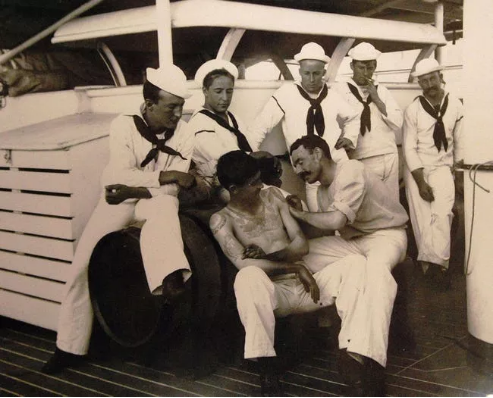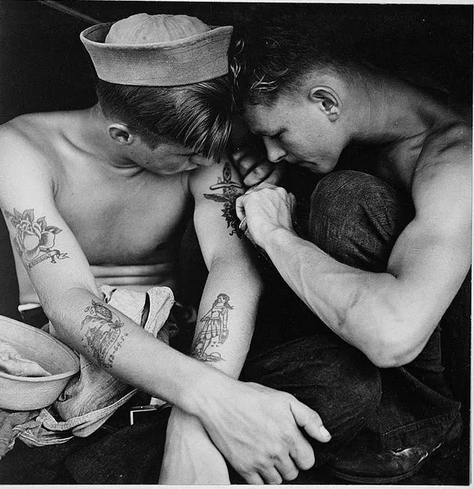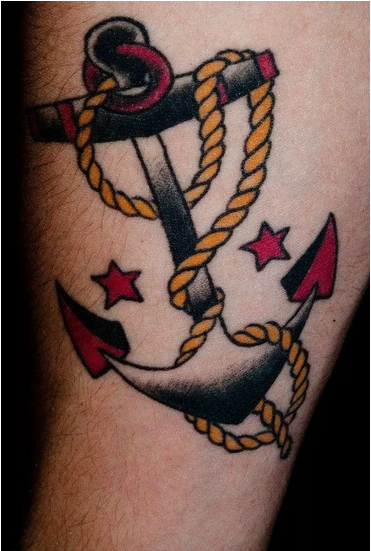What Were The Most Popular Tattoos In Every Decade Since The Turn Of The 20th Century?
January 2020 posted on Ranker.com
********** look in the 1980’s for acknowledgement of Pat Fish’s role in popularizing Celtic tattooing
Tattooing has been around for thousands of years, practiced as part of cultural and traditional beliefs around the world. Tattoos have different meanings to different people; some tell a story, while others are a reminder of where you have been or a guide to where you want to go.
Trends in 20th-century tattoos in the United States have a bit of all of this mixed in. Tattoos from the 1910s and 1920s trace a path from sailors to the counterculture of the 1960s that rejected social norms.
Tattooing has seen innovation and change across the decades, but vintage tattoo designs never completely fall by the wayside. Take a look at the most popular tattoo designs across the decades
1910s: Nautical Themes And Ladies In The Buff
During the late 19th century, tattooing in the United States was reportedly common among members of high society. Around the turn of the century, however, tattooing was called "the most vulgar and barbarous habit," and deemed appropriate "for an illiterate seaman, but hardly for an aristocrat."
Connections between seamen - regardless of literacy - and tattooing can be traced far earlier than the 20th century. During Captain James Cook's nautical explorations of the 1700s, his sailors tattooed themselves after finding the practice among Polynesian groups so impressive. Tattooing was also a form of identification among sailors around the world.
Tattooing became a souvenir of sorts, indicating where a sailor had been. Some tattoos were also superstitious in nature. For example, pigs and roosters tattooed on the feet were meant to protect a sailor from drowning.
Among other tattoos common for sailors were inappropriate works of art. Sailors with unclothed women tattoos on their person were so endemic that, in 1909, the US Navy insisted they would reject any candidates with "indecent or obscene tattooing."
By the 1910s, major naval communities and port cities began to see the development of tattooing businesses. In New York City's Bowery, Samuel O'Reily's tattoo shop was a destination for sailors in search of a tattoo. In Norfolk, Virginia, August "Cap" Coleman opened a tattoo parlor in 1918 where he inked sailors.
1920s: Cosmetic Enhancements
During the early 20th century, tattooing became more technically advanced with the introduction of new, more efficient tattooing equipment. Combined with a lower cost for tattoos, the art form became more common among the working classes - and caused the elite to shun the practice.
Yet tattooing as a form of cosmetic enhancement grew in popularity throughout the 1920s among the wealthier classes. Women had makeup tattooed on their faces - everything from blush to lip liner to eyeliner. The notion of tattoos as permanent makeup was introduced by British tattoo artists George Burchett and Sutherland MacDonald before it made its way to the United States.
Because tattooing was becoming more popular in the United States, many communities in the 1920s took steps to prohibit youths from getting tattoos.
1930s: Your Social Security Number
When the United States government introduced Social Security numbers (SSN) in 1935, people went to great lengths to connect themselves with their new numerical identification.
For many women, an SSN was a sign of autonomy, one they could wear engraved on a necklace or even inked on their body. Men would have their numbers inked on their arms, backs, or chests, sometimes accompanied by patriotic designs. According to reports, at least one man had his SSN tattooed on his dentures so he would always have it on hand.
Tattoo artists noted the increase in business that resulted from the issuance of SSNs. Mildred Hull, a tattoo artist in New York, recalled how her business "picked up again in the late '30s thanks to FDR." One San Francisco tattoo parlor claimed it averaged "two social clients a day."
1940s: Military Themes And Japanese Aesthetics
"Time marking" and "pledge" tattoos grew in popularity during the 1940s, with the latter dominant among military veterans. Soldiers had their military units and divisions inked onto their bodies, a permanent sign of patriotism and dedication to their brothers-in-arms.
Apart from circus performers and tattoo artists themselves, soldiers and sailors remained the dominant population to get tattoos in the United States. Patriotic images, like eagles and flags, often appeared with other military symbols, such as anchors and ships.
Tattoo artists also picked up new aesthetics during military service, and artists like Sailor Jerry Collins incorporated Asian themes and images into his work. Sailor Jerry, whose real name was Norman Keith Collins, introduced waves and wind motifs alongside animals like tigers and dragons.
Collins added colors to the practice and even developed his own ink. He also promoted cleanliness and invented new techniques to sterilize tattooing equipment.
1950s: Colorful And Hidden
There was a backlash against tattooing in mainstream society in the United States during the 1950s, one that caused many individuals to hide their tattoos. Tattoos were associated with deviant behavior, counterculture, and general rejection of the norm. The connection made tattoos all the more popular with nonconformists.
Motorcycle crews, prisoners, and perceived deviants were all linked by the trend. The military pushed back against tattooing as well, once again telling people to avoid tattoos.
There was still a lot of innovation during the 1950s, however. Men like Phil Sparrow (born Samuel Stewart) and Lyle Tuttle both worked to promote cleanliness and sanitary practices in the profession while simultaneously incorporating color into their work. Influenced by Sailor Jerry Collins, tattoo artists also inked large, cohesive tattoos rather than isolated, unrelated pieces of art.
Phil Sparrow, a former university professor who left academia to become a tattoo artist, noted that for women during the 1950s, tattooing was a complicated practice that blended possession and liberation. Women bikers, for example, were considered "property" of their men once tattooed, but getting ink simultaneously rejected socially constructed notions of femininity.
1960s: Custom ‘American Traditional’ Designs
During the early 1960s, there were concerns about the health risks posed by tattooing. In 1961, after a hepatitis outbreak was blamed on a tattoo artist at Coney Island, the New York health department banned tattooing. The tattoo ban in New York City remained in effect for 36 years.
Across the rest of the country, however, tattooing experienced a resurgence during the late 1960s. In what many have termed a "Tattoo Renaissance," a return to traditional anchors and pin-up girls was tweaked with new colors, techniques, and effects.
Tattooing during the 1960s was also associated with celebrities. Musicians like Janis Joplin proudly waved their tattoos in front of audiences. As more and more pop culture icons got inked, the practice became increasingly appealing.
1970s: Flowers, Wristbands, And More 'Feminine' Designs
What began in the late 1960s - the so-called Tattoo Renaissance - reached its apex in the next decade. Heavily influenced by hippie culture, feminism, and civil rights movements, tattoos became more and more mainstream.
The idea that one's body was one's own, and available for display and expression, prompted many women to get tattoos. Peace symbols, flowers, and other traditionally feminine designs began to appear on women - often put there by a growing number of female tattoo artists.
Color still had a lot of appeal and remained one of Sailor Jerry's calling cards. He wrote letters to tattoo artists around the United States, influencing their designs and practices while recognizing he "was the first dirty ba*tard to start using purple, white, yellow and blue - now they're all trying to do it. Color is here to stay - good color that is!"
1980s: Tribal Symbols And Celtic Knots
Japanese influences on the art of tattooing were present during the late 1940s and '50s, but it wasn't until the '70s and '80s that Chicano and tribal icons became popular within the practice. Chicano-style tattoos, characterized by single colors and fine lines, had been popular among prisoners and certain social groups during the 1950s, and became increasingly inked onto members of the middle class during the 1980s.
Tribal symbols, most notably those of the Celts (think Celtic knots) were spread by artists like Pat Fish. Based in California, Pat Fish specialized in Celtic tattoos and designed them based on her research and exploration of the topic. Fish, who has Celtic heritage, says that "[b]y specializing in this type of tattooing I get to meet people who are my same kind of dog, who think bagpipes are thrilling and knotwork mazes are a kind of visual prayer of complexity."
Alongside a wider availability of historical information and images of tattooed people, artists and observers theorize this sense of community and belonging allowed for people to adopt and adapt traditional symbols to meet their individual needs. As author Victoria Lautman writes, tribal tattoos were less colorful and grandiose and could be used to "accentuate each body's own structure and contours."
1990s: Barbed Wire And Butterflies
Tribal tattoos remained popular during the 1990s, but emerging trends among college-aged girls brought small, feminine icons to the forefront of tattoo culture. Butterflies, hearts, and flowers were increasingly tattooed on ankles, shoulders, stomachs, and lower backs. Celebrities influenced the trend with actors like Angelina Jolie and Drew Barrymore openly displaying their ink.
Another emerging trend among tattoos during the 1990s was barbed wire, often in the form of an armband. Pamela Anderson famously got a barbed wire tattoo in conjunction with her film, aptly named Barb Wire, in 1995. She commented:
The makeup people were going to paint this on my arm every day, but I had a tattoo artist just sketch it on me and I wore it around for a half a day to see how it looked. I decided I’d just go ahead and get it done. I love it. I think it’s very feminine, for barbed wire.
Barbed wire tattoos have taken on more meanings to represent suffering and confinement as well.
2000s: Asian Characters
Tattoo trends around the turn of the century were heavily Asian in nature, with Japanese and Chinese characters becoming popular. Sometimes, Chinese and Japanese tattoos were meant to represent a sentiment or idea, but according to tattoo artist Anthony Wayne, "As long as it’s not a stupid word, they don’t care about what the word is, just as long as it looks cool."
Patrons didn't always get what they bargained for or something easily understood. In 2000, New York Knicks player Marcus Camby showed off his tattoo featuring two Chinese characters: the symbols for "to inspire" and "race." It was a perplexing combination to Chinese speakers, but had personal meaning to the athlete. "I've always liked how one Chinese character means more than just one word; it can be an entire idea," he said. He believes the symbols mean "I strive to be the best" and "I love my family."
Mistranslation and blatant inaccuracies were common enough that they became a bit of a joke during the 2000s.
2010s: Geometric Designs, Natural Elements, And Watercolors
Tattoo popularity continues to expand and, within the past decade, has become still more abstract and colorful. Geometric designs - an homage to sacred geography, simplicity, and minimalism - and natural symbols like stars and trees exist side-by-side to emphasize nature, calm, and a host of other potential meanings for the tattoo-wearer.
Watercolor tattoos have also allowed for both more realism and a heightened sense of fantasy, depending on how they're used. Some watercolor tattoos resemble paintings. Others blend traditional and conceptual images, with the skin serving as a canvas for blended shades and hues.











